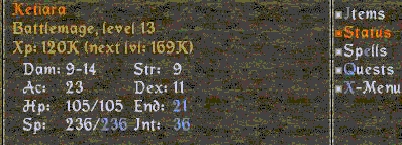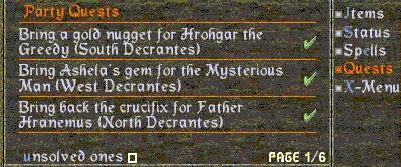Review: Legacy
Score:
89%
Version Reviewed: 1.05
Buy Link | Download / Information Link
"When Sunamur, the mighty evil sorcerer died, the world of Morales was liberated. Two of his most powerful servants, two brothers took over the throne: Mersant Orasare and Sohl Orasare.But some months later Sohl betrayed his brother: he seized Mersant's magical forces, and imprisoned him in the Tower that was guarded by many of his faithful students. The balance of power has broken down..."

This is how Legacy by Redshift starts. Legacy is an AD&D RPG (just keep reading, I’ll explain later) for the Palm and now also in a brand new version for the Nokia Communicator. Legacy is shareware, but the unregistered version allows you finish the first couple of quests before asking for a registration key. By this time you’re addicted to the game. If not, you wouldn’t have made it to that point.
Starting Legacy can be a problem: the game needs at least 3.1 MB free operating memory on the Communicator. Although 3.1 MB for such a complex game isn’t much (I personally feel it’s a stroke of genius if you can create such a complex game in so little memory), the Communicator only has 4 MB in total. Most users have far less than 3 MB available after their Communicator starts due to memory resident software installed on their machines. Fortunately Redshift offers some help and links to tools on their website that can help you increase the available memory on your Communicator.
In Legacy you're in command of a team consisting of knights, adventurers, clerics, mages or highlanders to find and defeat the evil Sohl. On your way, you will encounter numerous monsters (spiders, wolfs, lizards, vampires, mages, evil eyes, dragons etc) whose only aim is to destroy your party. And if battling monsters isn't enough for you, there are also a lot of tough puzzles you have to solve in order get to the end.
You start your game with only one member in your team (randomly chosen by the game). As soon as you get into the first city, you can add new members to your party by hiring them in the city tavern. There are different types of hirelings (adventurers, knights, mages, clerics, etc) each with their own special talents and skills. For example, a cleric can learn defense and healings spells, a battle mage can learn attack spells and an adventurer is good at attacking your enemies with knifes, swords and bows.
Navigation is easy. You walk around by pressing the arrow keys. The left side of screen displays a map of the area you've already discovered with an arrow showing you which direction you're heading. The middle of the screen is the game area and to the right you can see your party.

During your exploration of the forests, cities, dungeons and swamps, you will find people hanging around (sometimes literally). These are called NPC's (my guess is that this means Non Playing Characters since they're not moving) and they usually have some information or items for you. Sometimes the information is free, but more often you'll have to find something for them in order to get the stuff you need. In Legacy this is called a quest.

While you’re playing the game, winning (and losing) battles and solving quests, the characters in your party mature, making them either stronger, more precise, tougher or more intelligent. You can choose which attributes to increase each time a character advances to the next level.
As said before, moving around is easy, but Legacy itself is not an easy game. If you're not familiar with Advanced Dungeons and Dragons Role Playing Games jargon (that's what AD&D RPG means), it will take you some time to figure out what hp, sp, ac, str, end, int, and dex are and how to spend the achievement points for different types of characters.
And although you can find a lot of information and tips on the Internet about how to play this game (the Palm version was released last year and this game is identical to the Communicator version), Legacy does not include a manual yet. For this reason I've included a small manual about which keys do what in the Communicator version of Legacy and a tiny glossary of terms at the end of this review.
The graphics in Legacy are very good. Candles have moving flames, doors open and close realistically and sometimes it even rains (although the first time I saw rain in the game, I thought something was wrong with the video-memory of my Communicator).
Legacy isn’t easy. Pretty soon after the start of the game, you'll need to fight some difficult battles with dwarfs and lizards. Since the opponents are always tough to fight (as your party gets tougher the monsters also get tougher) some members of your party can get killed during battle. Fortunately, you can exchange members of your party at every inn. Later in the game, you can even buy 'Raise dead' scrolls or have a Cleric or Knight learn a spell that can raise the dead.
Battle is not real-time, but turn-based: after an opponent had his turn, he/she will wait patiently for every member in your party to strike (very convenient). Only the characters in the top row (number 1 and 2) can strike an enemy directly. The characters in the bottom row can only participate in the battle by casting spells or using bows and arrows.

Every hit a party member receives, does damage to his health. But, unlike in some of the tougher AD&D games, in Legacy you’re allowed to restore your health during battle by drinking Healing-potions or increase your spellcasting power by drinking Mana-potions without losing your turn.
In every city there’s at least one inn. As said before you can hire new members for your party here, but you can also play a quite addictive game of cards where you have to beat the other player by casting spells to reduce his health-power. The game is not only fun to play, but also a perfect way to check out the effect of some spells (like curse, mental shield, poison cloud, vampire touch, harm undead etc).
Inns also allow you to spend the night. It will cost you some money, but during sleep the health and mana-powers of your party are fully restored.
Every city also has three kinds of shops where you can buy armor, weapons, spells and potions. The gold and items you find exploring the forests, cities, caves and dungeons can be spent here to upgrade your armor, weaponry and buy potions that will restore your health, mana, cure poison etc. Some shops are only open during daytime; others are only open at night.
Every member of your party has it’s own inventory containing all the items he or she is carrying (there seems to be no limit to the amount of stuff a character can carry, so be sure to pick up everything you find). From the inventory you can (un)wear clothing and armor, (un)wield weapons, learn spells, drink potions. It’s also possible to hand items from the inventory of the current character to other party members. If an item is not entirely suitable for the current character, you can press the exclamation mark to get an explanation why.
At the left side of the screen you see a picture of the currently selected character. A nice detail is that as soon as you wear a piece of armor or wield a weapon, the picture of the character is updated as well.

From the inventory you can also access the status screen of the current character. In this screen you’ll find the current strength (str), dexterity (dex - accuracy), endurance (end) and intelligence (int). Numbers in blue indicate that the value is increased by a spell (Bless for example) or by a magic item (you may carry a staff that increases your spell points or your endurance). Each time a character reaches the next level (the game will inform you about that), the status window allows you to add 4 points to str, dex, end and/or int. Higher strength causes more damage to opponents. Building intelligence builds spell power (and spell resistance) but also increases the ability to learn new spells from spell books.

The quests windows show all the quests for your party. Solved quests are marked with a green checkmark.

And after you’ve solved all quests in Legacy (which will take you some time), you can buy an expansion pack with tougher monsters and more difficult puzzles. Redshift is also about to release a free world editor (currently still in beta) that will allow you to create your own worlds. The entire game was written with this editor, in which you can use advanced scripting to create complex quests and puzzles.
Keys in the Communicator version
Most of the time it’s easy to see which keys you can press, since Legacy highlights the hotkeys in blue. In the game screen however there’s no such information. In the table below you’ll find a (complete?) list of key presses you can use in the game screen and the actions they perform (yes Rafe, I know a review shouldn’t be a manual but if you’re going to recommend a piece of software that doesn’t include a manual (yet), people at least should know some basic commands):
Key Action
Arrow-keys Move around
1 – 4 Select character 1, 2, 3 or 4.
If already selected, opens the character’s inventory.
Space, P Use / talk (pick up stuff, use spheres, talk to NPC’s)
M Full screen map
Enter Hit/strike (also hit cracked walls to reveal hidden passages)
C Open spell window (for casting spells or using magic items)
Tab Change spell-window contents (show curse/heal spells, attack spells or magic items like scrolls)
E End turn (even when not in battle, this allows you to let an opponent come closer without moving yourself)
X Return to main screen
Ctrl+S Sound on/off
Ctrl-Up Increase volume
Ctrl-Down Decrease volume
Conclusion
This review has been written almost three weeks later than planned, since I wanted to finish the game (which is not easy, especially the last couple of maps are very hard in terms of puzzles and battles) before writing it.
My experience with Dungeon and Dragons games is very outdated. It dates back to the 80s where you had to move a diamond, heart or spade around to the screen in order to explore the dungeons, in which ghosts (zeroes) and spiders (X-es) tried to kill you. And even though that was only a simple character based game on a mainframe in our university, it was a lot of fun to play (and yes, it did cause me to fail some exams).
Legacy is what I saw in my mind’s eye when playing that old game (although the graphics in Legacy are a lot better than in my imagination). And now I don’t need to imagine it anymore, it’s real. Even better, I don’t need a mainframe; I can take it with me wherever I go. It is almost impossible to believe that such a complex game can run in the limited memory of the Communicator.
Legacy is a very addictive game with beautiful graphics, animations and sounds. Legacy will keep you glued to your communicator for weeks. I’ve just started on the expansion pack (which is really tough) and I expect that there will be many new maps now that the editor is (almost) available. Legacy is here to stay.
Even if you’re not familiar with role playing games, you owe it to yourself to give this game a try.
My score for Legacy is 89 (that means "highly recommended"). If you like playing games on your Communicator, the score should be 95 (meaning "must have, brilliant").
Reviewed by Heyden Smith at
